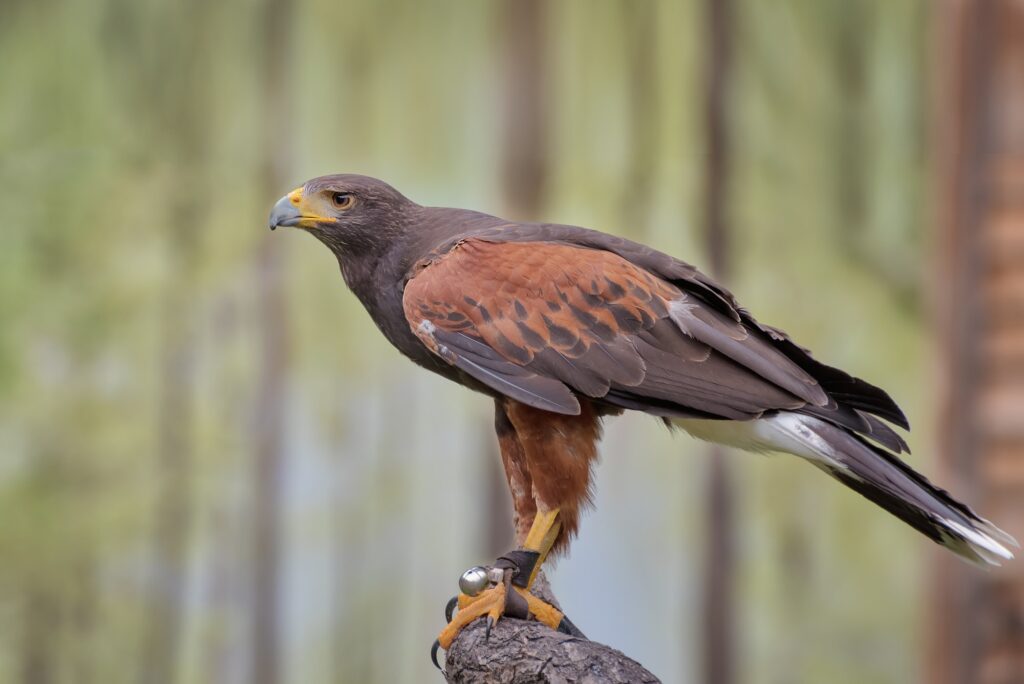New Mexico’s wildlife is as diverse as its land. That’s why it’s no surprise that the state’s home to 546 different species of birds. The forested mountains, oak-woodlands, and deserts make a diverse habitat for many bird species. This variety makes New Mexico a remarkable bird-watching destination.
With a high plateau and deep canyons, the Great Plains sweep through the east until the Pecos River in the south. In the northern part of the state lies the Rocky Mountains region. That is where Wheeler Peak, the highest point in New Mexico, is located.
Hawks are one of the most abundant bird species in New Mexico. These intelligent birds of prey can be spotted there all year round.
Let’s get to know the hawks in New Mexico!
Cooper’s Hawk
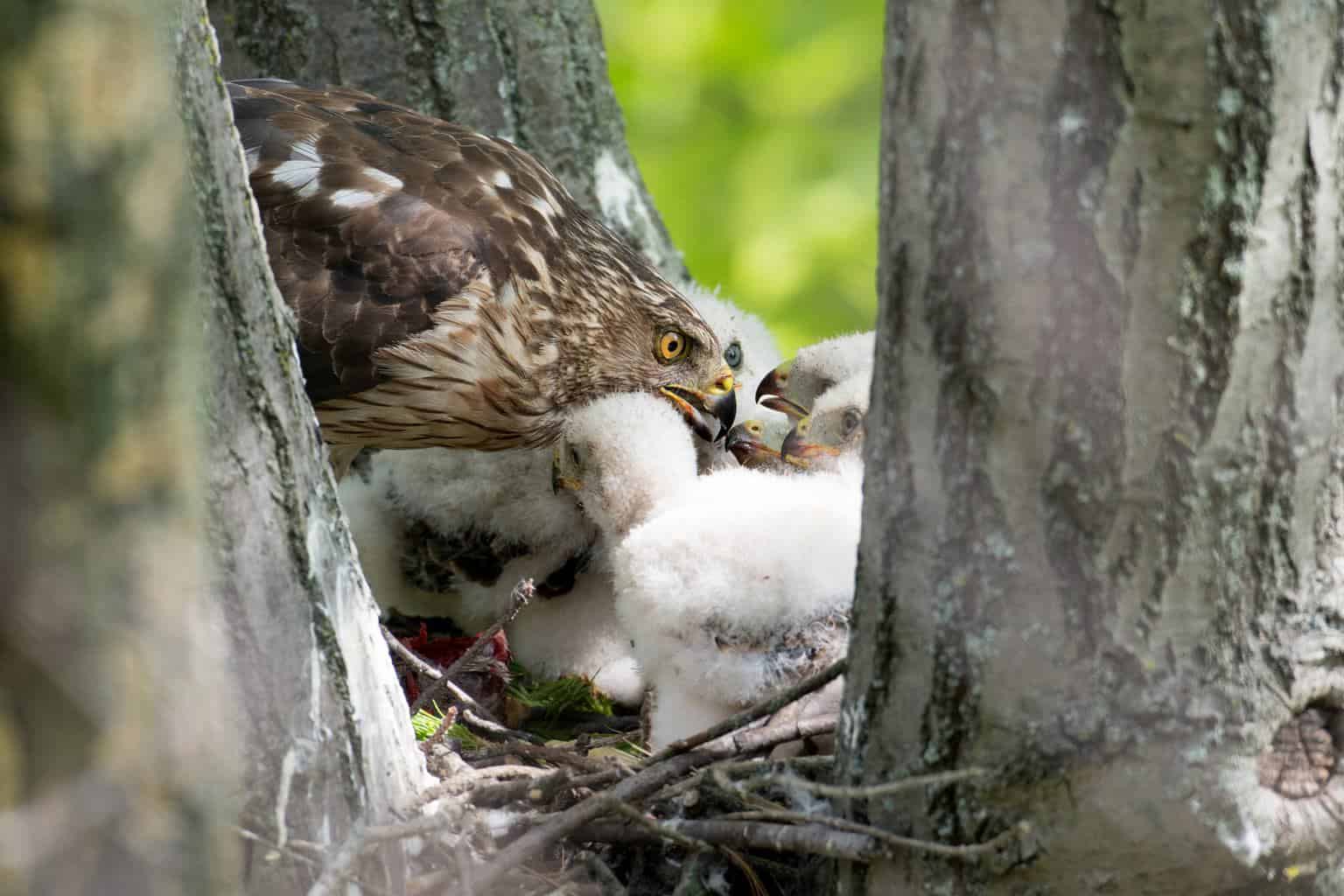
-
Scientific name: Accipiter striatus
-
Length: 14.6-15.3 inches (males), 16.5-17.7 inches (females)
-
Weight: 7.8-14.5 ounces (males) , 11.6-24.0 ounces (females)
-
Wingspan: 24.4-35.4 inches (males), 29.5-35.4 inches (females)
You’ll recognize Cooper’s species of hawks by their reddish-pleated chests and blue-gray backs. Their long, rounded tails have thick dark bands that are visible as they fly.
This bird of prey has a flap-flap-glide flying pattern that’s typical of accipiters. They can be spotted in deep forests, forested mountains, and at backyard bird feeders. There, these hawks will be hunting for small to medium-sized birds or small mammals to eat.
Harris’s Hawk

-
Scientific name: Parabuteo unicinctus
-
Length: 18.1-23.2 inches
-
Weight: 18.2-31.0 ounces
-
Wingspan: 40.5-46.9 inches
Harris’s hawk is a dark bird with reddish shoulder patches and a fairly long, white-tipped tail. As these birds take flight and you observe them from below, you’ll notice they have reddish-brown inner wings, too.
Harris’s hawk, named after naturalist Edward Harris, is among the more sociable species of hawks. Unlike most raptors, Harris’s hawks travel and hunt in groups. They even nest in groups of three — two males and one female — and work together to raise the juveniles.
Fun fact: the oldest known wild bird of this species was 15 years old and found in the Land of Enchantment.
Northern Harrier

-
Scientific name: Circus hudsonius
-
Length: 18.1-19.7 inches
-
Weight: 10.6-26.5 ounces
-
Wingspan: 40.2-46.5 inches
The northern harrier is easy to identify, thanks to their flat, owl-like faces, broad wings that assume a V-shape while they fly, and long, rounded tails.
The medium-sized raptors rely on both hearing and vision to capture their prey. This species’ dietary preferences change depending on where they are and what time of year it is, but they generally prefer to eat small birds, including songbirds and flickers, and mammals.
Northern harriers build their nests in the ground concealed in grasses, so while you’re out exploring New Mexico’s scenery, be sure to watch your step.
Sharp-Shinned Hawk
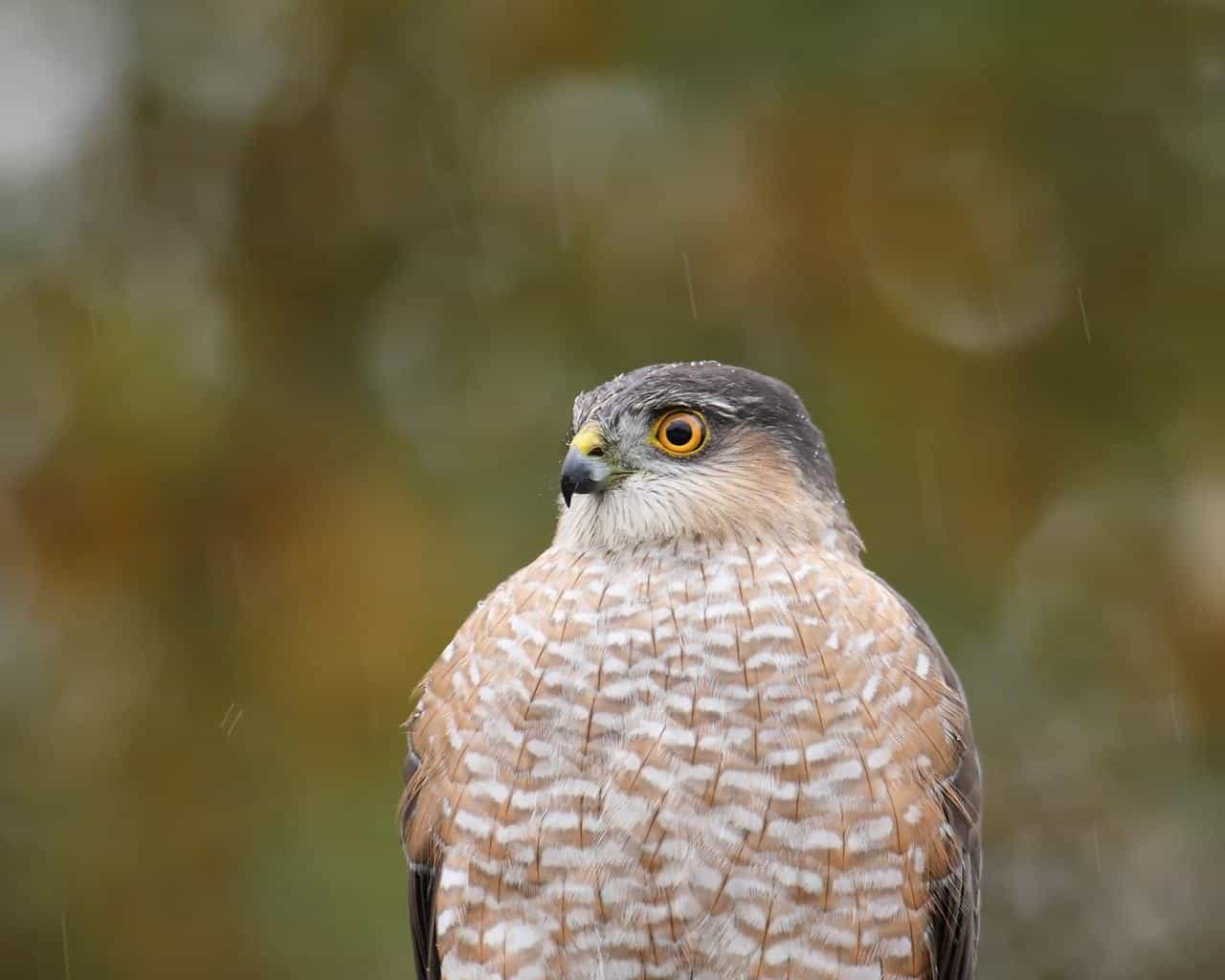
-
Scientific name: Accipiter striatus
-
Length: 9.4-13.4 inches
-
Weight: 3.1-7.7 ounces
-
Wingspan: 16.9-22.1 inches
The sharp-shinned hawk is tiny — in fact, it’s the tiniest species in the accipiter family. They have a characteristic flap-and-glide flying style, but they’re so fast, you won’t even notice; all you’ll see is a blur of blue-gray feathers.
This tiny hawk has a small head that doesn’t project beyond the wings during flying and horizontal red-orange stripes across its breast.
Find birds of this species spending their days in mixed or coniferous forests or at backyard bird feeders looking for a songbird or squirrel for lunch. During the late fall, as they migrate as far south as Panama, you can see these birds in flocks of dozens or even hundreds, so be sure to look up and behold this fascinating sight.
Red-Tailed Hawk
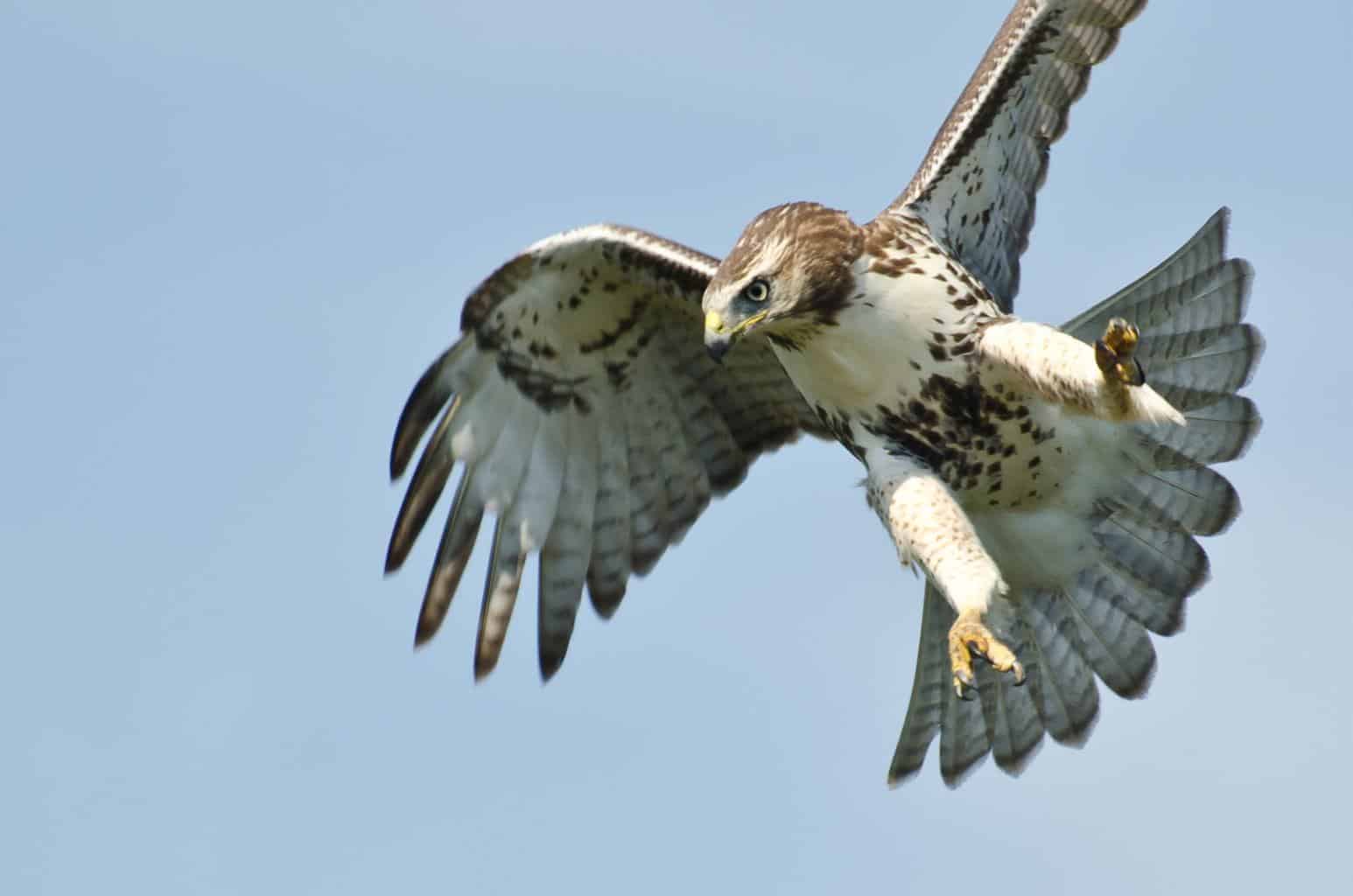
-
Scientific name: Buteo jamaicensis
-
Length: 17.7-22.1 inches (males), 19.7-25.6 inches (females)
-
Weight: 24.3-45.9 ounces (males), 31.8-51.5 ounces (females)
-
Wingspan: 44.9-52.4 inches (males), 44.9-52.4 inches (females)
Your chances of finding the red-tailed hawk increase in the wintertime, where the bird will likely be standing alone on the edges of trees. You’ll easily identify them by their hoarse “kee-eee-ar” sound. Even if you’ve never seen this bird in person, it’s safe to assume you’ve already heard its cry before. When a hawk or eagle appears in a film or TV show, the sound used is more than likely the caw of a red-tailed hawk.
This species is named after the birds’ cinnamon-red tails, but they also have chocolate brown bodies and streaked bellies. When it’s time to eat, find these hawks feeding on mammals, mostly rodents.
Northern Goshawk
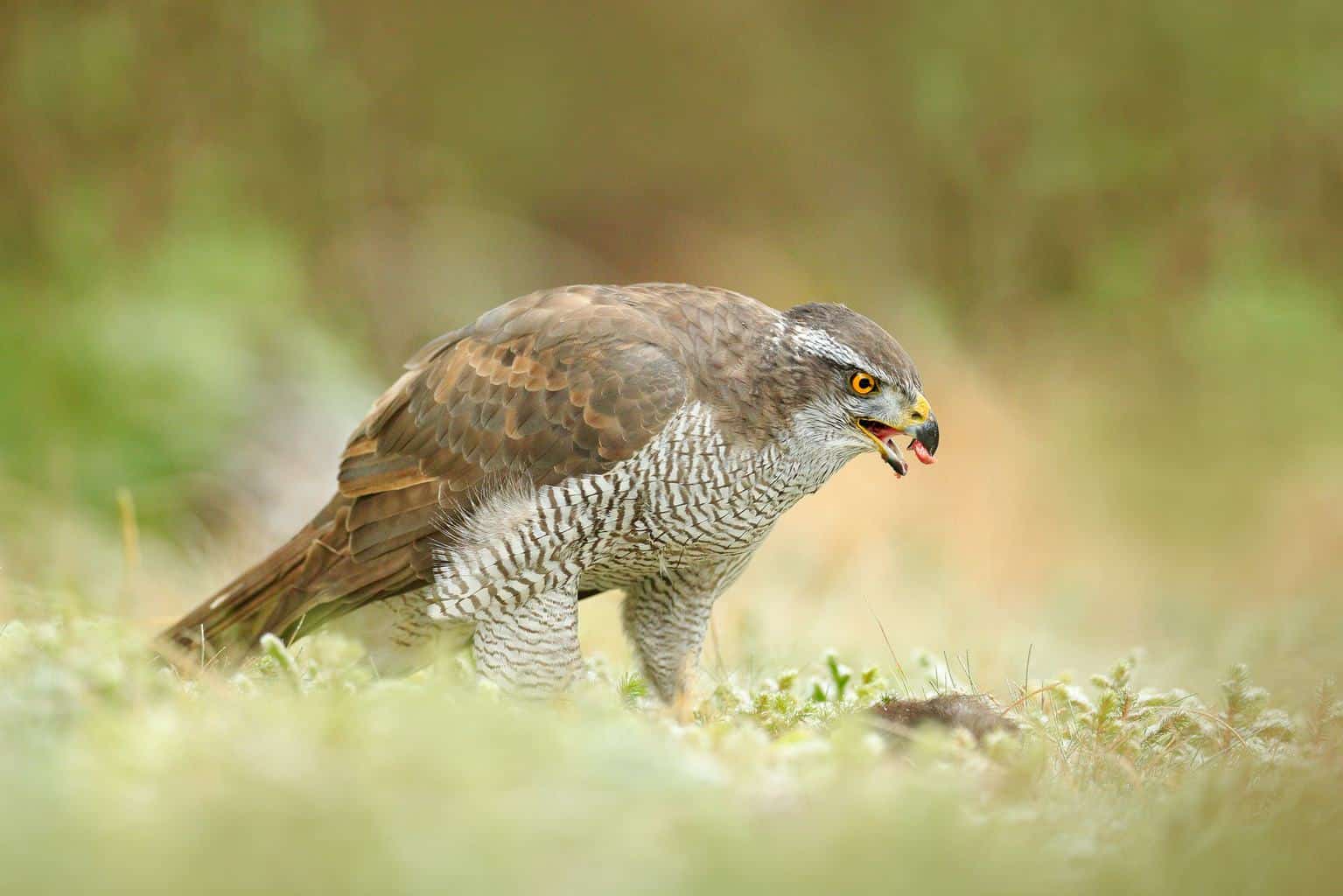
-
Scientific name: Accipiter gentilis
-
Length: 20.9-25.2 inches
-
Weight: 22.3-48.1 ounces
-
Wingspan: 40.5-46.1 inches
Northern goshawks are stealthy predators that live in hardwood deciduous forests and prey on birds. The secretive birds usually tuck themselves away in the woods, but occasionally, you’ll find them in open areas or along the forest edge.
These birds have dark heads with pale barred underparts, as well as reddish-orange eyes and a white eyebrow-like stripe of feathers above them. This is the largest accipiter species, with its size falling somewhere between a crow and a goose; of the two sexes, females are larger than males.
Swainson’s Hawk

-
Scientific name: Buteo swainsoni
-
Length: 18.9-22.1 inches
-
Weight: 24.4-48.2 ounces
-
Wingspan: 46-54 inches
Winter isn’t the only time you can spot hawks in New Mexico; the Swainson’s hawk species can be spotted in the state mostly during the summer.
The large buteo birds have distinctive white underwings and dark heads. Males of this species have gray heads, while those of females are usually brown. This description fits most but not all of Swainson’s hawks, as their appearance is quite varied. Some of these birds can be reddish, while others are almost all black.
Common Black Hawk
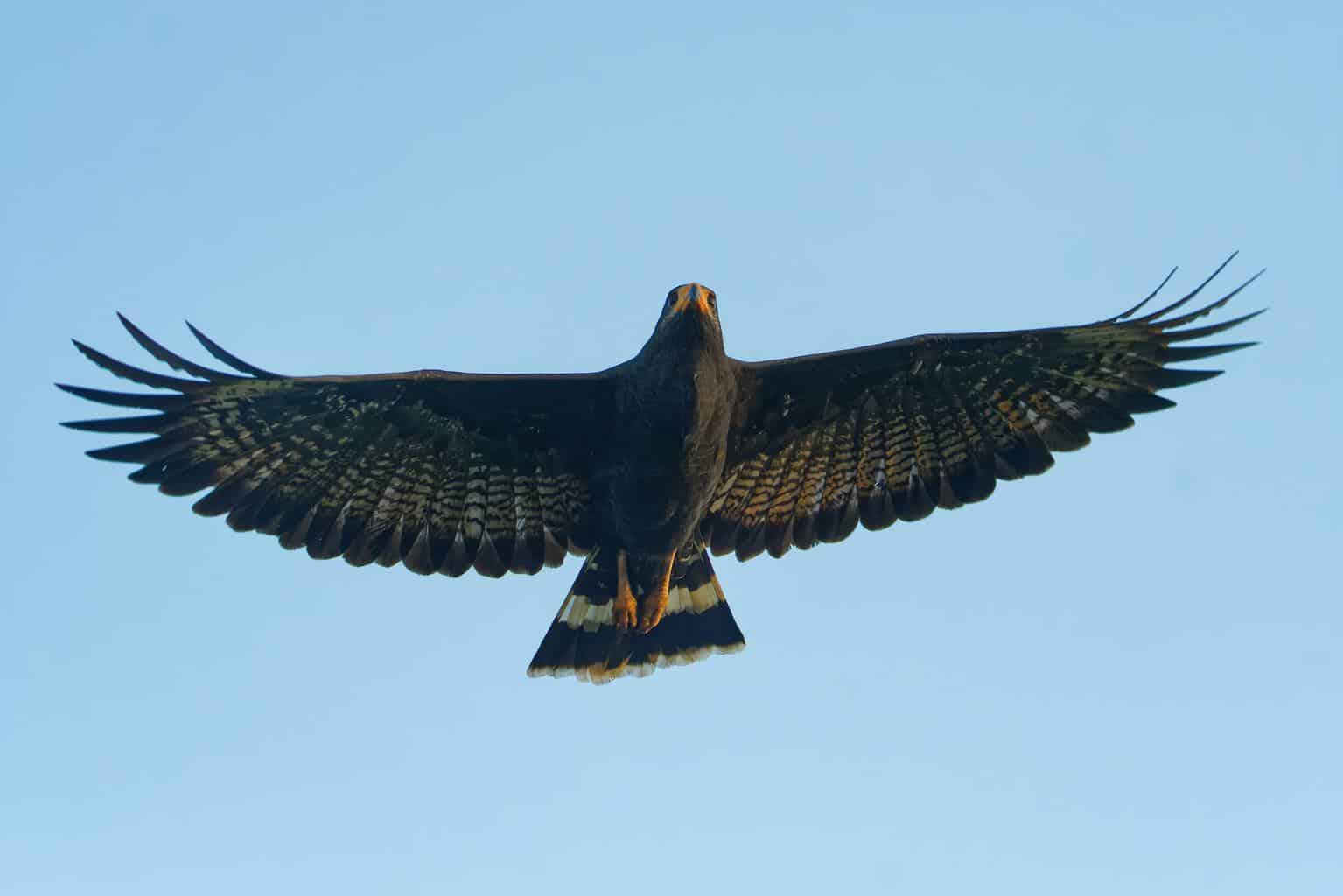
-
Scientific name: Buteogallus anthracinus
-
Length: 17–21 inches
-
Weight: 33 ounces
-
Wingspan: 50 inches
Despite its name, spotting the common black hawk isn’t quite as common as you might think. You’ll have to rely on a little bit of luck — and the hot, summer months — if you hope to see this species in New Mexico.
You can identify this unique black hawk by its remarkable “spink-speenk-spink-spink” sound, or by its appearance; it, of course, is all black except for its yellow legs and cere.
The common black hawk’s diet is diverse, as it feeds on crabs and small vertebrates, and it will occasionally make a meal of fish, frogs, small birds, or snakes.
Broad-Winged Hawk
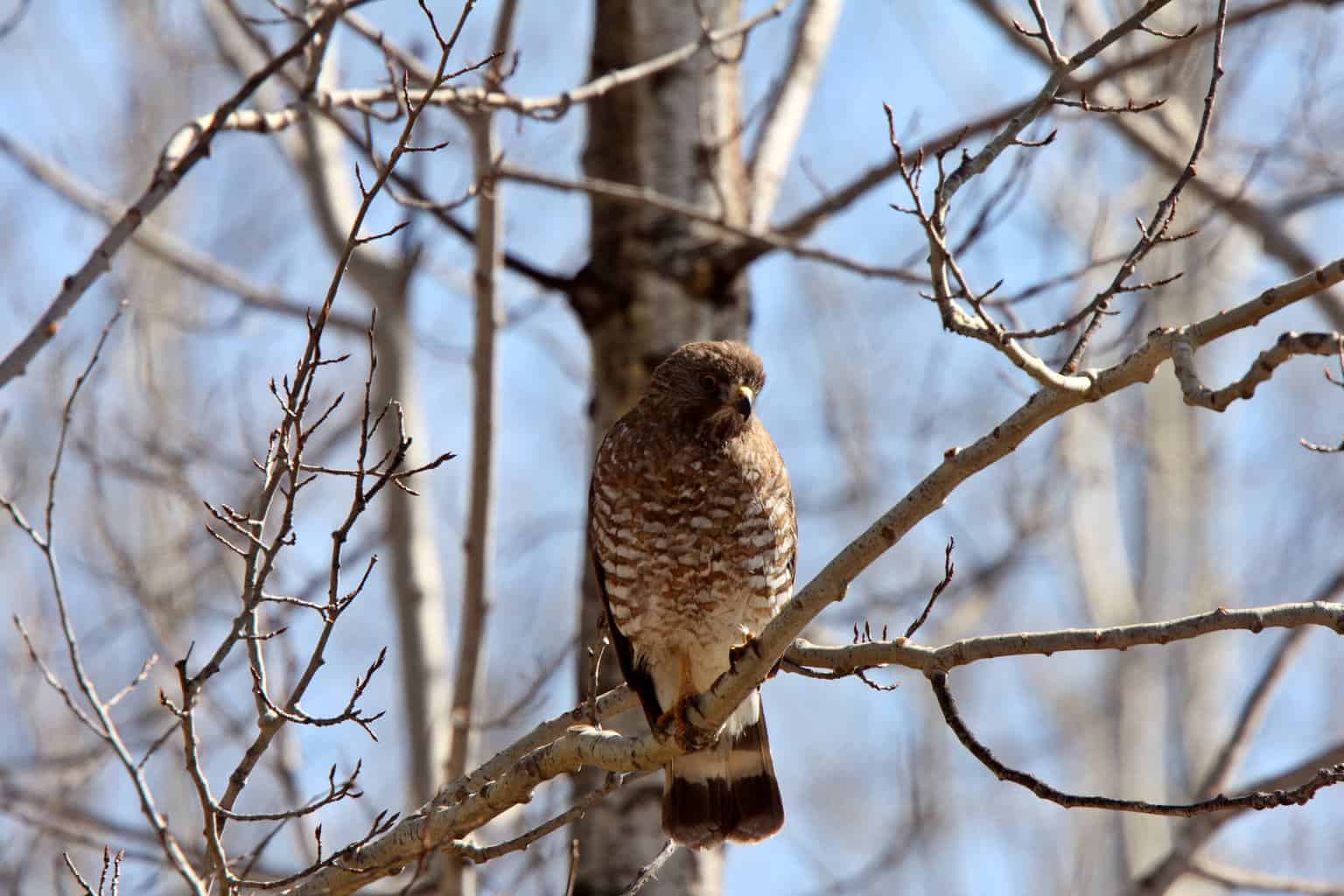
-
Scientific name: Buteo platypterus
-
Length: 13.4-17.3 inches
-
Weight: 9.3-19.8 ounces
-
Wingspan: 31.9-39.4 inches
Your best chance of seeing broad-winged hawks comes during the fall when they migrate, as huge flocks of these birds fill the sky. As you watch them from below, you’ll easily see their barred underparts and pointed wings.
These small raptors have reddish-brown heads and black and white banded tails, and of course, broad wings. Juveniles of this species are light brown with streaked underparts.
Find this inconspicuous bird hanging out underneath the forest canopy looking for amphibians, reptiles, mammals, and birds to eat.
Zone-Tailed Hawk

-
Scientific name: Buteo albonotatus
-
Length: 17.7-22.1 inches
-
Weight: 21.4-4.9 ounces (males), 29.8-33.0 ounces (females)
-
Wingspan: 29.9-30.9 inches (males), 32.2-34.5 inches (females)
With their black and white barred underparts, zone-tailed hawks are quite similar to turkey vultures.
You can find this species flying low and steadily above treetops, looking for lizards, mammals, and birds to attack from low heights. These birds live mostly in places with uneven terrains like upland deserts and mountain pine forests.
They build their nests, however, on higher surfaces like tall trees or near cliffs usually between 30 and 100 feet off the ground. These birds are quite territorial and will defend their nests aggressively should another bird get too close.
Rough-Legged Hawk

-
Scientific name: Buteo lagopus
-
Length: 18.5-20.5 inches
-
Weight: 25.2-49.4 ounces
-
Wingspan: 52.0-54.3 inches
The boldly-patterned rough-legged hawks occur in dark and light morphs and have broad wingtips, which are swept back and give an M-shape to the wing when the birds are in flight.
This species loves the cold arctic temperatures and will head down to the warmer temperatures of New Mexico during the winter months. The rough-legged hawk’s fully-feathered legs not only give the bird its name, but also keep it warm during the breeding season in the far north.
Rough-legged hawks can be spotted perching on utility poles or fence posts, where they look for small mammals to feed on.
Ferruginous Hawk
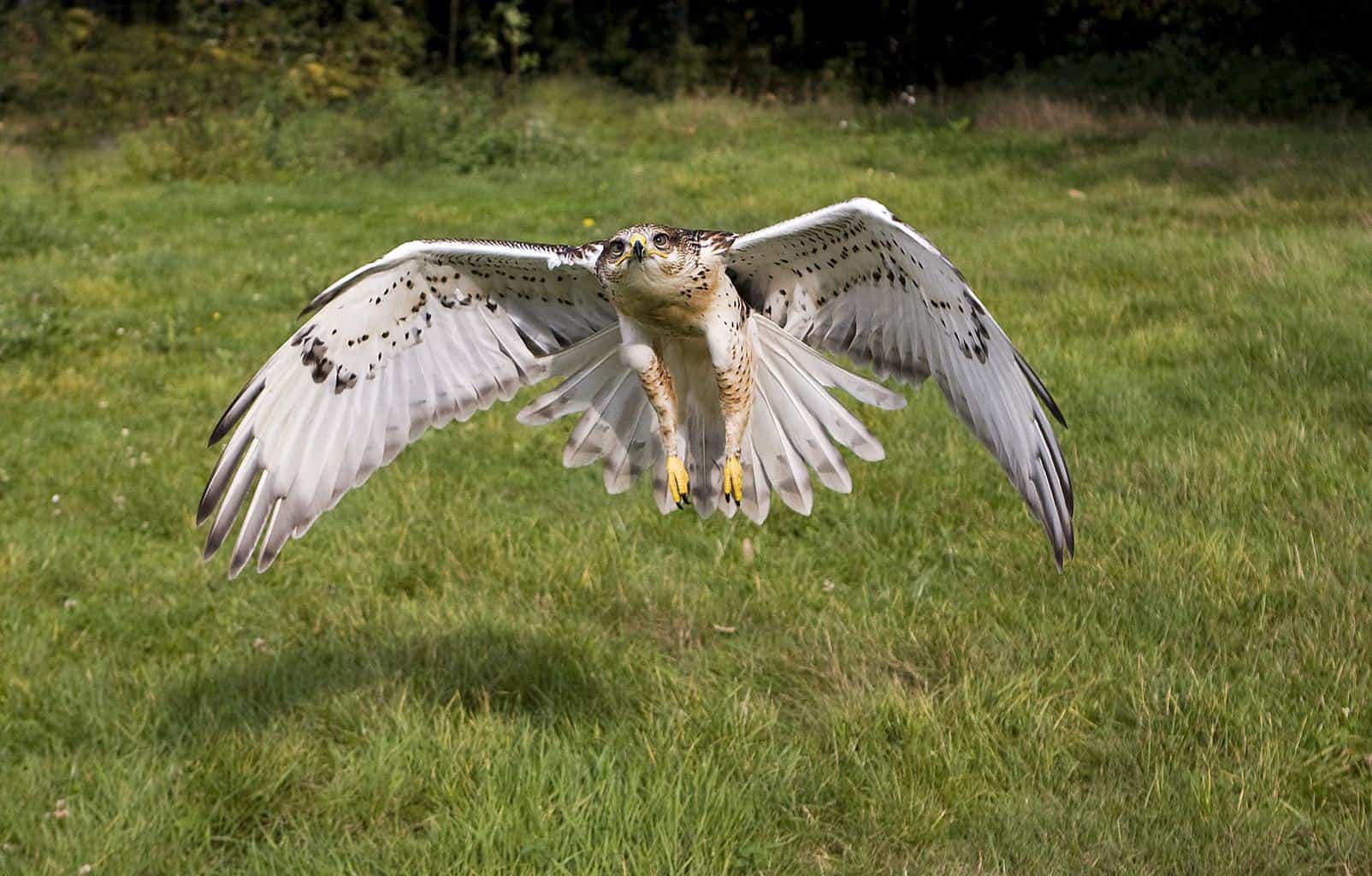
-
Scientific name: Buteo regalis
-
Length: 22.1-27.2 inches
-
Weight: 34.5-73.2 ounces
-
Wingspan: 52.4-55.9 inches
The beautiful ferruginous hawk has a strikingly white underpart and relatively long wings that narrow to form pointy tips, a characteristic that’s generally uncommon among buteo birds. Its pale underside and rusty legs form a V-shape when it’s flying.
As with many other hawk species, you can find these birds in two different color morphs. Light morph ferruginous hawks have white underparts and pale heads, and dark morphs are a shade of deep, chocolate brown.
Ferruginous hawks, the largest North American birds in the hawk family, live mostly in grasslands and prairies. They eat pretty much anything available, like juvenile jackrabbits, pocket gophers, or squirrels.
Red-Shouldered Hawk
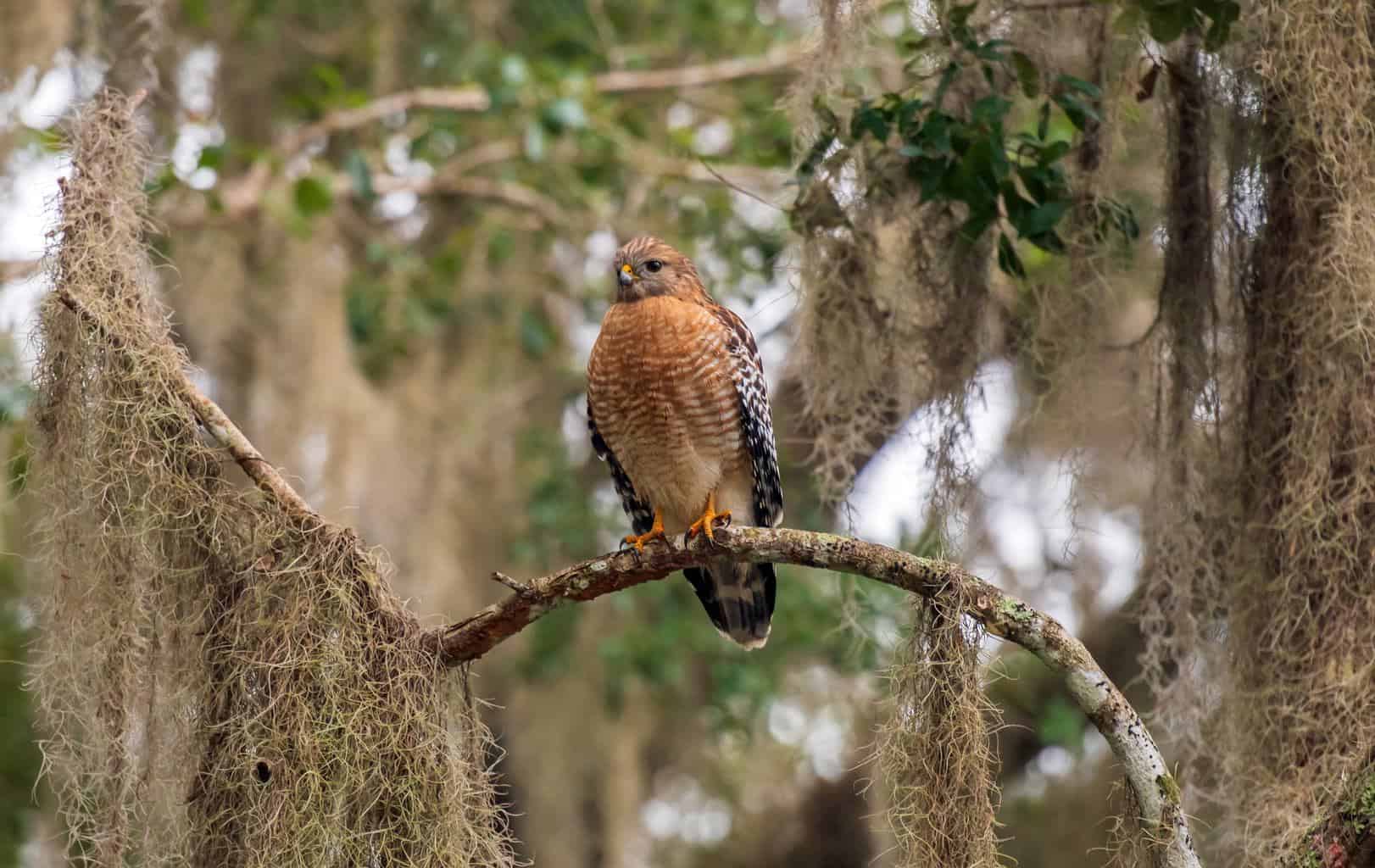
-
Scientific name: Buteo lineatus
-
Length: 16.9-24.0 inches
-
Weight: 17.1-27.3 ounces
-
Wingspan: 37.0-43.7 inches
The distinctive red-shouldered hawks sport red feathers on their shoulders and dark and white checkered wings. As they perch on top of tree branches and utility wires, you can see the red stripes on their chests.
You may hear this bird before you see it, as you can clearly pick out their unique “kee-rah” sound, especially in the springtime.
The red-shouldered species’ diet varies depending on the region and time of year. In some parts of the U.S., you can find these birds eating crayfish, but in others, you’ll find them hunting for voles, chipmunks, frogs, or toads.
Gray Hawk
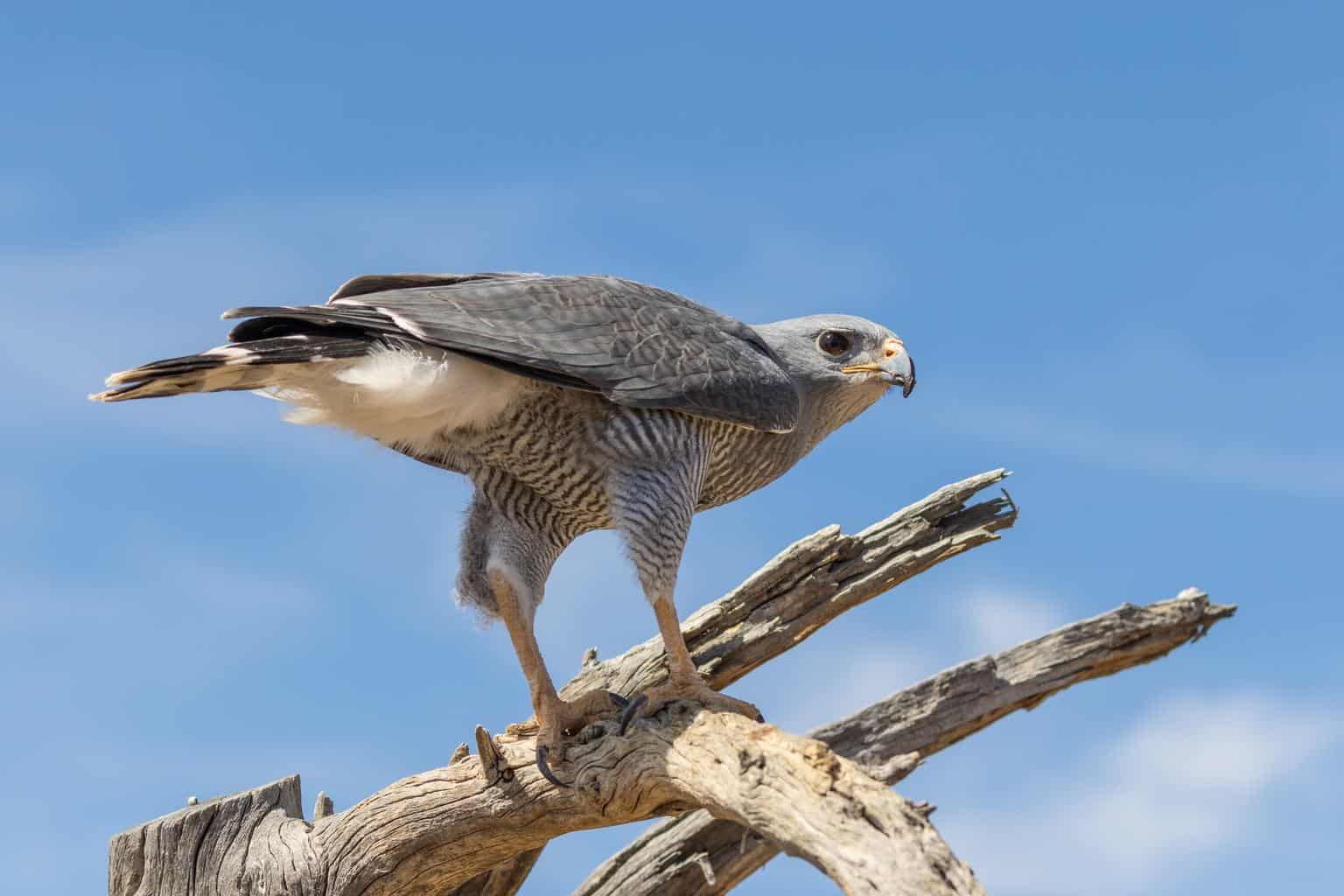
-
Scientific name: Buteo plagiatus
-
Length: 18–24 inches
-
Weight: 13.8-16.6 ounces
-
Wingspan: 35 inches
Gray hawks are common birds of North America’s southwest region, being spotted around southern New Mexico and Arizona and down into Mexico. Here, they settle into wooded areas around streams, perching themselves onto the branches of tall trees.
These pale gray hawks have smoothly barred chests and black and white tails. Not only can you recognize this species by its appearance, but they’re easily identifiable by their sound: a distinctive “hoooooweeo.”
They feed mainly on lizards and small mammals.
Conclusion
Not only are hawks skillful fliers, but they’re also intelligent creatures. They prefer to hunt just before nightfall when the sun isn’t burning. Unlike other predatory birds, hawks kill their prey with their talons, not with their beaks. Numerous hawk species can be found in New Mexico any time of the year, and their unique colors and hoarse sounds make them effortlessly identifiable.
If you want to know about other bird species you can find there, check out this article about the woodpeckers of New Mexico.

